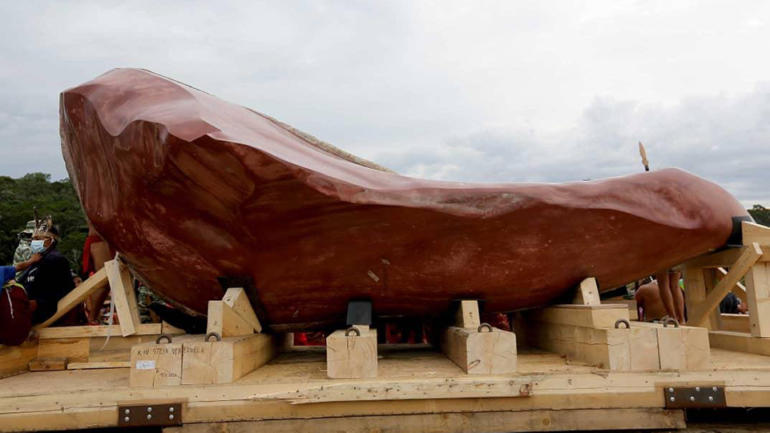The Kueka stone is hundreds of millions of years old, but in the last 22 years of its existence it has become the source of a protracted dispute between the government of Venezuela and a German conceptual artist.
It all began in 1998, when Wolfgang Kraker von Schwarzenfeld, an aristocratic figure with flowing white hair and a taste for adventure, arrived in Venezuela on his three-masted yacht, looking for the perfect rock.
His idea was to select a pair of stones in five continents. He would leave one of each pair in the country of origin and transport the others back to a park in Berlin, where they would be displayed as part of his “Global Stone project.” The rock from the Americas, was destined to be named “Love”.
He found the Kueka, a 30-ton whale-shaped slab of pinkish jasper quartz in Venezuela’s immense Canaima National Park. He later said he could have chosen any of the hundreds of stones in the area. All the necessary paperwork for his unusual export, he insists, was completed. The rock was loaded onto a transporter and then onto a cargo boat to Germany. It was then placed alongside 4 other massive stones in Berlin’s Tiergarten Park.

Not everyone however was pleased with the idea. There were reports at the time that indigenous people in Canaima thought it was inappropriate that a rock had been seized from their traditional land. These concerns were taken up by the newly-elected socialist President of Venezuela, Hugo Chávez, when he took office in 1999. Some anthropologists and tribal leaders said that the Kueka was also not a random rock, but a holy stone for the Pemon people. Removing it, they said, was blasphemy.
Schwarzenfeld, now in his 90s, has dismissed the criticism. No one at the time had told him there “was even a hint of holiness” about the stone, he said.
Decades passed, but finally, last year, both the artist and the German authorities agreed that if Venezuela really wanted the Kueka back, then it could be removed from the Berlin park. Venezuela has paid the cost of the repatriation, a 12,000km voyage across sea and land. It now sits just a few hundred metres away from the very spot where it was taken in 1998. It will be repositioned, for eternity, in the coming weeks.
Venezuela’s culture minister, Ernesto Villegas, told CGTN he felt that bringing the stone back had been entirely worth the cost and the effort, even though his country is in the midst of an economic crisis and the world is confronting COVID-19. “It is something worthy of recognition,” he said. “In the midst of the pandemic, there is a space for culture. The cultural rights of human beings are as important as the basic rights to food, health, and work…and this stone means a great deal for the cultural identity of all Venezuelans”.
 CGTN America
CGTN America